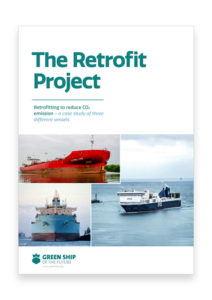With the goal of exploring how much the energy consumption, and thereby CO2 emission, can be reduced through retrofittable and proven technological solutions, 20 members of Green Ship of the Future have done a project series with a sample of high-volume vessels.
Three different vessels, Hafnia Lise, Victoria Seaways, and Maersk Tianjin were explored and actual data and operation profile of the specific vessels were used in the individual cases. The partners analyzed the data, identified areas with potential for energy optimization and calculated the expected cost in relation to its potential for fuel and CO2 reductions. The findings are analyzed on their potential to deliver a 3-year full return on investment (ROI). While the goal of this project is not to provide an exhaustive overview of all available technologies, more than a dozen different areas, with significant potential of savings, were identified.
The largest potential combined savings were 27,1%, equivalating to 5.208 tons CO2 a year. The case with the least potential in terms of percentage saving, 11,1%, is on the other hand the case with the largest CO2 reduction potential, equivalating to 7.350 less ton of CO2 emitted per year. This is due to a different operational pattern. While, there are differences between the individual vessels and participating providers analyzing the cases, and it is therefore not possible to directly compare them, there were several general learnings that can be drawn. These are elaborated in the conclusion. It is vital to mention that there are significant additional potential savings if a ROI of 3 years are not required. Further, because the actual fuel price for the sample period were used to calculate the ROI, the actual ROI is subject to changes depending on fluctuation in fuel prices the following years.
The exercise of optimizing the energy consumption is obviously important from an environmental perspective today and strategically it benefits from its correlations to financial savings from using fuel optimization. Though, even after a GHG neutral fuel is implemented, energy optimization remains vital. From an environmental perspective, because we will likely reach the zero emission vessels before the combined energy need of the world is covered by renewable sources – therefore renewable energy will still be a scares resource that we must not waste on inefficiencies. From a financial perspective it will be even more important than today, because all potential renewable alternatives are projected to be far more expensive than the fuel in use today, therefore the future business case of optimizing the energy consumption will be superior to today. Hence, the investments in technologies today will not only benefit the environment, it is also possible to do it in a way that make short term financial sense. Finally, the learnings and knowhow that are drawn from investments made in energy optimizing technology today, will most like prove to be a source of competitive advantage in the future and thereby increase likeliness of continuous profitability.
Background
The arguably most pressing environmental impact from shipping, is the emission of greenhouse gas (GHG) – especially the emission of CO2. It is evident that implementation of a GHG neutral fuel is necessary, from both an environmental, climate and compliance perspective, but it is also evident that it will be years before we can rely purely on sustainable sources of energy. Therefore, we must constantly seek innovations in existing assets and ensure optimal energy efficiency, to keep the negative impact on environment as low as possible and reduce the overall energy cost. This need is further stressed due to the long-lasting nature of the vessels, which represent large investments and a high percentage of the operating cost.

